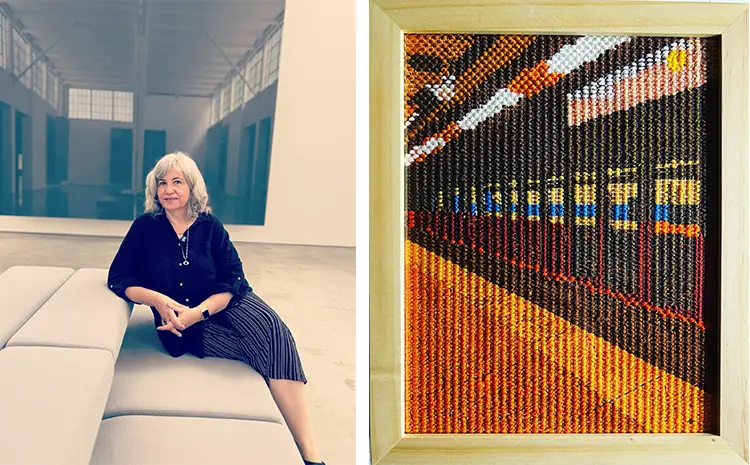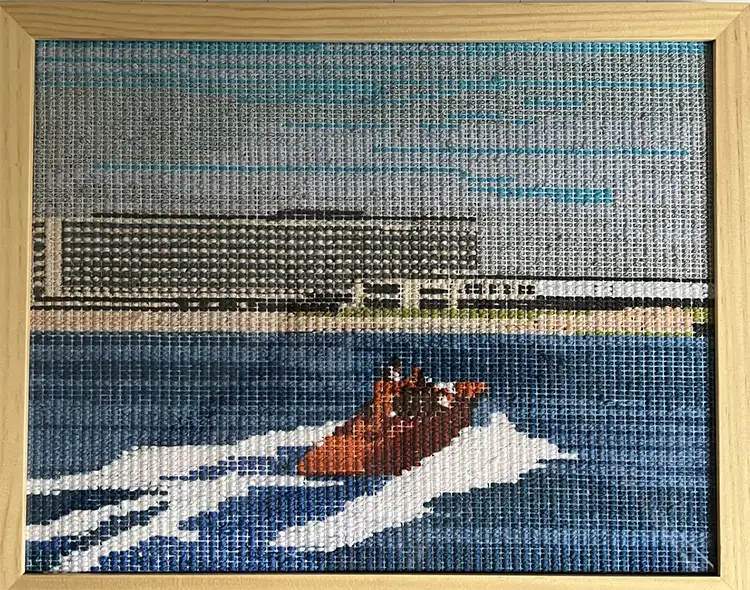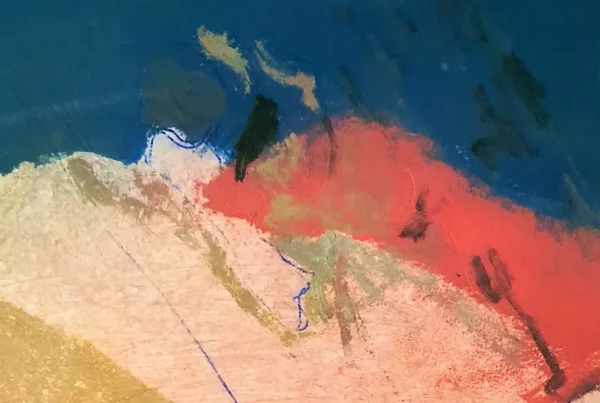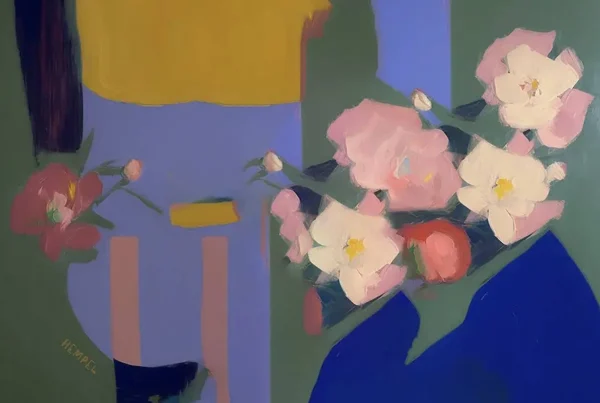“The longer I work on a piece the softer and the suppler it becomes. It adjusts to your hands and forms a kind-of extension to your body.”
A Tapestry of Beginnings: Anna Novakov ’s Bi-Cultural Origin and Impact on Her Artistic Journey
In 1959, Belgrade—then a vibrant hub within Yugoslavia—welcomed the birth of Anna Novakov, whose subsequent life and career would straddle cultures, countries, and creative paradigms. The crux of her multifaceted identity was forged in a youthful era punctuated by a transatlantic relocation; a move propelled by her physicist father, Tihomir Novakov, accepting a distinguished position at the University of California, Berkeley in the mid-1960s. The journey by ship and plane from Belgrade to New York and finally, Berkeley, not only physically transported the family across continents but also metaphorically navigated them through contrasting sociocultural worlds, each leaving an indelible imprint on Novakov’s nascent creative and personal identities.
The artist’s childhood and adolescent years were spent oscillating between two notably disparate environments: the socialist utopia of post-war Yugoslavia during holiday breaks and the eclectic, spirited counterculture movements of the Bay Area during the academic year. This bicultural existence allowed Novakov to absorb a rich tapestry of influences related to diaspora, migration, and displacement. It subsequently became evident that these experiences would weave themselves into the canvas of her critique and creation, establishing a foundational narrative that would pervade her professional journey.
In 1992, after obtaining her doctorate from New York University, Novakov asserted herself as a pioneering figure in the art criticism landscape, exploring and illuminating the compelling intersections between art, emerging technology, and utopian spaces. Her explorations did not simply rest on mere observation but dove deeply into the undercurrents of each domain, extracting nuanced insights that reflected both her acute academic rigor and her personally lived experiences of traversing divergent worlds.

Instructing and Illuminating: Novakov’s Notable Contributions to Art History and Academia
In the early 1990s, Anna Novakov established her professional and personal life in California, alongside her husband, artist Rik Ritchey, and their daughter, Christina. Embracing a career in academia, she dedicated herself to the pedagogy of art history and the innovation of hybrid courses at esteemed institutions such as the San Francisco Art Institute and Saint Mary’s College of California. Novakov has consistently demonstrated a profound commitment to nurturing and inspiring the next generation of artists and historians, contributing immensely to the cultivation of a vibrant and intellectually stimulating educational environment.
Subsequent to her return to California, Novakov’s scholarly endeavors unfolded prolifically, evidenced by the publication of over twelve books that delve into diverse aspects of contemporary art, modernist architecture, and the contributions of Serbian women artists. Her writings not only serve as pivotal resources within the academic community but also strive to demystify the complexities of art and architectural history for a broader readership. In her pursuit to unveil and celebrate often-overlooked narratives, she casts light on significant, albeit previously obscured, artistic and architectural phenomena.
Moreover, while Novakov’s formal training is rooted in art history, she has never allowed disciplinary boundaries to restrict her collaborative spirit. Her interdisciplinary projects, notably with artists across the spheres of architecture, the built environment, and design, epitomize a synthesis of scholarly inquiry and practical engagement. Whether curating exhibitions in the US and Europe or co-creating alongside artists, Novakov navigates through various facets of the art world, unifying theory and practice, and thereby enriching both the tangible and intellectual landscapes of contemporary and historical discourse.

Melding Threads of Past and Present: Novakov’s Entrepreneurial and Artistic Odyssey
Embarking upon a rich tapestry of artistic and entrepreneurial journeys, Anna Novakov navigates through varying spheres of the creative industry with both an introspective and innovative approach. In the sun-drenched expanses of New Mexico, she, alongside her partner, artist and composer Ron Hutt, founded Freehold Taos, an artist residency program that kindles the flame of creative expression amidst its attendees. Moreover, the entrepreneurial spirit of Novakov breathed life into Mala Igla, a textile design company based in Santa Fe. This venture allowed her to weave her artistry into the fabric of interior design, as she collaborated on custom wallpapers and bespoke fabrics tailored for interior designers.
With a move to the bustling, vibrant life of New York, Anna consciously pivoted from a business-focused trajectory to a more intensive cultivation of her artistic craft. Immersing herself in an educational sojourn, she honed her textile design capabilities at prestigious institutions such as Parsons and the Textile Art Center located in the cultural hub of Brooklyn. This shift not only underscored her commitment to perpetual learning but also illuminated the adaptive nature of her artistic journey, showcasing an ability to meld entrepreneurial and artistic endeavors into a harmonious existence.
Intricately intertwined with her heritage, Novakov’s medium and thematic choices pay a heartfelt homage to her familial lineage of skilled needlework craftswomen. Her grandmother Maja, renowned for her chromatic and intricate textiles, has notably seeped into Novakov’s work, becoming both muse and mentor across generations. Anna has celebrated this connection through various expressive forms, such as immortalizing Maja’s designs in ink on her own skin to commemorate her 60th birthday and crafting hand-embroidered wall art that reverently nods to the resilient women of her Balkan heritage. In every stitch and pattern, she threads the legacy and artistry of her ancestry, weaving a contemporary narrative that is indelibly inked by the past.

Of Memories and Metropolitans: Anna Novakov’s Artistic Tapestry Intertwining Personal and Urban Narratives
Anna Novakov’s artworks, particularly an engaging series titled “Private Diaspora,” immerse themselves in memories harvested from her Yugoslavian childhood, encapsulating urban elements like cars, trams, and quaint street scenes. Concurrently, another series, “Portable New York,” adroitly navigates through the enduring aspects of New York’s cityscape, offering viewers a tangible connection to the bustling metropolis. Her creative endeavors are profoundly influenced by the Bauhaus movement’s female textile artists, with notable figures such as Anni Albers and Gunta Stölzl providing inspiration, while contemporary artists like Do Ho Suh and historical architectural installations by Lilly Reich and Mies van der Rohe’s Velvet and Silk Café weave themselves into the rich tapestry of her artistic influences.
In a dream project, Novakov envisions crafting a life-sized needlework representation of the K67 kiosk, a creation from 1967 by Slovenian architect Saša Mächtig. This piece would serve as a tangible homage to its sustained presence and utilitarian significance across Eastern Europe. The artist’s vision extends beyond mere representation, encapsulating a broader tribute to both form and function in utilitarian design, binding it within the delicate yet potent medium of needlework.
Novakov’s workspace, strategically situated in New York and France, is characterized by a minimalist and portable setup, meticulously designed to harmonize with her small-scale hand needlework practice. This setup allows her artistic creation to weave through various settings and distractions, such as dynamic conversations or travel, rendering her art-making process as versatile and nomadic as the experiences and memories encapsulated within her creations. This capacity for mobility in her practice does not merely facilitate convenience but propels the perpetual interweaving of diverse cultural and temporal tapestries into her work.






